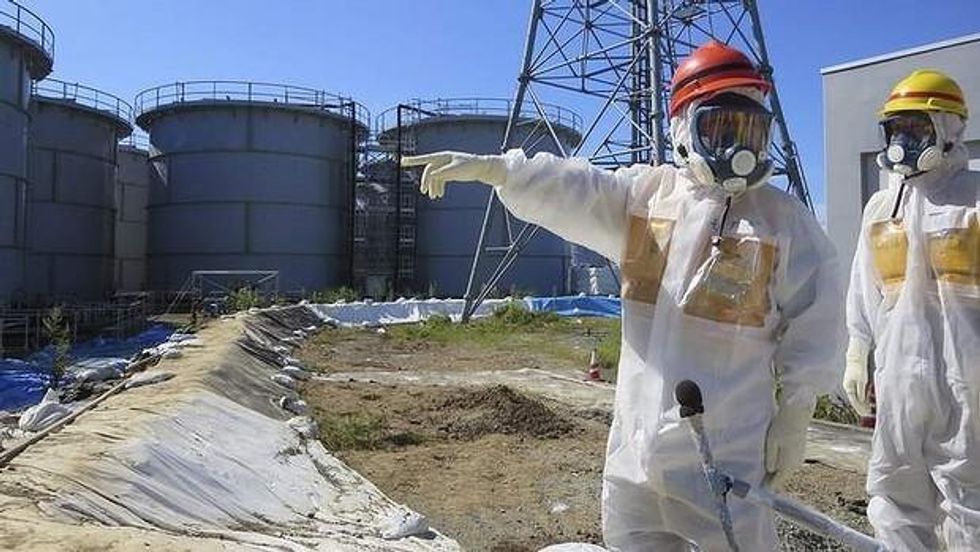

SUBSCRIBE TO OUR FREE NEWSLETTER
Daily news & progressive opinion—funded by the people, not the corporations—delivered straight to your inbox.
5
#000000
#FFFFFF
To donate by check, phone, or other method, see our More Ways to Give page.


Daily news & progressive opinion—funded by the people, not the corporations—delivered straight to your inbox.

Five months ago, measurements taken by TEPCO showed surging levels of the highly radioactive strontium-90 at a groundwater well. However, despite requests from the country's Nuclear Regulation Authority (NRA) for all such data, TEPCO withheld that information until Wednesday.
"We did not hear about this figure when they detected it last September," Shinji Kinjo, NRA's taskforce on contaminated water issues at Fukushima, told Reuters. "We have been repeatedly pushing TEPCO to release strontium data since November. It should not take them this long to release this information."
"This is not an appropriate way to deal with the desire of the public (for transparency) and in particular, the regulator, which is now very closely regulating issues related to public health, the environment and so on," said Martin Schulz, a senior research fellow at the Fujitsu Research Institute.
Meanwhile, adding to this week's news, TEPCO also announced that samples taken from a separate groundwater well near the plant are now detecting a record 54,000 becquerels per liter of another radioactive substance, cesium.
This level more than doubles all previous records of cesium in groundwater near the plant, the last being 22,000 becquerels detected in a separate observation well in July 2013, The Japan Times reports.
In a separate bit of bad news Shanghai Daily reports that there may be a new leak at the site of the well containing cesium, which is located just 50 meters from the Pacific Ocean.
______________________
Trump and Musk are on an unconstitutional rampage, aiming for virtually every corner of the federal government. These two right-wing billionaires are targeting nurses, scientists, teachers, daycare providers, judges, veterans, air traffic controllers, and nuclear safety inspectors. No one is safe. The food stamps program, Social Security, Medicare, and Medicaid are next. It’s an unprecedented disaster and a five-alarm fire, but there will be a reckoning. The people did not vote for this. The American people do not want this dystopian hellscape that hides behind claims of “efficiency.” Still, in reality, it is all a giveaway to corporate interests and the libertarian dreams of far-right oligarchs like Musk. Common Dreams is playing a vital role by reporting day and night on this orgy of corruption and greed, as well as what everyday people can do to organize and fight back. As a people-powered nonprofit news outlet, we cover issues the corporate media never will, but we can only continue with our readers’ support. |

Five months ago, measurements taken by TEPCO showed surging levels of the highly radioactive strontium-90 at a groundwater well. However, despite requests from the country's Nuclear Regulation Authority (NRA) for all such data, TEPCO withheld that information until Wednesday.
"We did not hear about this figure when they detected it last September," Shinji Kinjo, NRA's taskforce on contaminated water issues at Fukushima, told Reuters. "We have been repeatedly pushing TEPCO to release strontium data since November. It should not take them this long to release this information."
"This is not an appropriate way to deal with the desire of the public (for transparency) and in particular, the regulator, which is now very closely regulating issues related to public health, the environment and so on," said Martin Schulz, a senior research fellow at the Fujitsu Research Institute.
Meanwhile, adding to this week's news, TEPCO also announced that samples taken from a separate groundwater well near the plant are now detecting a record 54,000 becquerels per liter of another radioactive substance, cesium.
This level more than doubles all previous records of cesium in groundwater near the plant, the last being 22,000 becquerels detected in a separate observation well in July 2013, The Japan Times reports.
In a separate bit of bad news Shanghai Daily reports that there may be a new leak at the site of the well containing cesium, which is located just 50 meters from the Pacific Ocean.
______________________

Five months ago, measurements taken by TEPCO showed surging levels of the highly radioactive strontium-90 at a groundwater well. However, despite requests from the country's Nuclear Regulation Authority (NRA) for all such data, TEPCO withheld that information until Wednesday.
"We did not hear about this figure when they detected it last September," Shinji Kinjo, NRA's taskforce on contaminated water issues at Fukushima, told Reuters. "We have been repeatedly pushing TEPCO to release strontium data since November. It should not take them this long to release this information."
"This is not an appropriate way to deal with the desire of the public (for transparency) and in particular, the regulator, which is now very closely regulating issues related to public health, the environment and so on," said Martin Schulz, a senior research fellow at the Fujitsu Research Institute.
Meanwhile, adding to this week's news, TEPCO also announced that samples taken from a separate groundwater well near the plant are now detecting a record 54,000 becquerels per liter of another radioactive substance, cesium.
This level more than doubles all previous records of cesium in groundwater near the plant, the last being 22,000 becquerels detected in a separate observation well in July 2013, The Japan Times reports.
In a separate bit of bad news Shanghai Daily reports that there may be a new leak at the site of the well containing cesium, which is located just 50 meters from the Pacific Ocean.
______________________